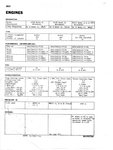Peter Gunn
Master Sergeant
I think they did, called them "pilots", and performance varied...
Cheers,
Biff
Eh, I've heard of 'em, doubtful they were an integral part of the equation though...
Follow along with the video below to see how to install our site as a web app on your home screen.
Note: This feature may not be available in some browsers.
Ad: This forum contains affiliate links to products on Amazon and eBay. More information in Terms and rules
I think they did, called them "pilots", and performance varied...
Cheers,
Biff
Note water is 40% more dense than avgas.
You don't want atomisation (droplets) but an actual vapour. Good mechanical atomisation at high pressure gets that started. It's possible that improved methods of water injection is what allowed the use of B4+ MW50 over C3+MW50.
Either way it's an interesting data sheet. Water usage is clearly very economical.
I believe the data is probably good though it is not necessarily indicative of how the Japanese would have used the engine.
Oh by the way, any idea why there's often such a wide disparity between performance figures given by the Japanese and what these tests of captured aircraft tell us? I have always wondered this and apart from some of these results being "calculated", one has to believe that the Japanese were very critical when it came to testing, while the TAIC tended to be overly optimistic. Any thoughts on this?
Hello DarrenW,
You need to be a bit more specific as to which test results you are disputing
Some Allied tests seem higher than typical numbers published in books, some are much lower.
Sometimes the same basic aeroplane has both high and low test results from different captured examples.
Just remember though that condition, maintenance and spares are always a problem with captured equipment.
- Ivan.
Oh, but they were. That's why water injection never really worked in cars. Cars have drivers, not pilots...Eh, I've heard of 'em, doubtful they were an integral part of the equation though...
Ivan what's the source of "ADI starts at +180 mm" ?
I'm very sceptical that a engine need ADI for rated power
Thus a maximum speed might be that listed for the prototype or an earlier version with an inferior engine which did not reflect what was in service. This is working on the assumption that you are actually seeing the numbers from Japanese specifications.
may have appeared like advanced; actually, I think it was dictated mainly by desperation. Indeed, nowadays we've many supercharged cars: how many have a methanol-water injection?
We know DB played with spark plugs as well as piston strength, compression ratio, spark timing to get from 1.7 ata to 1.8 ata and latter.
Spark plugs are a good issue most neglect, Guessing for say a Me109 going from 800hp cruise @1.05ata? to 1800hp boosted @1.8ata? would not ideally be using the same heat range plugs, if you want to avoid fouling from too cold or pre-ignition from too hot.
I suspect water injection was kinder to plugs under high boost than neat 150 octane would have been? Apparently the Allies 150 octane had so much "lead" it fouled plugs in 20-30 hours so there were no clear technical winner. And as that US test on the Frank admits water injection was a very economical solution.
A not-much talked topic. The Japanese installed water-alcohol injection in many, if not most of their engines by 1944-45, though the exact data is not that widely available, at least to my knowledge....
